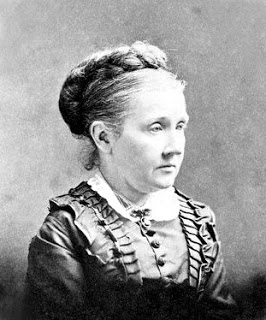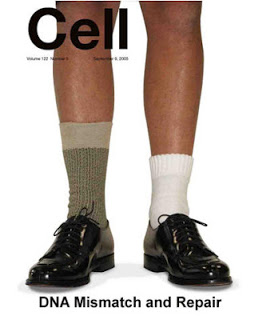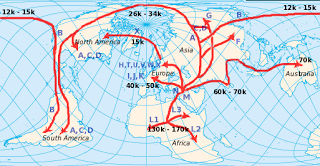Biology
Biology concepts ? inheritance patterns, mitochondria, fertilization, lineage, mitochondrial Eve
- Mitochondrial Dna Organization Is Variable
KEY CONCEPTS:Animal cell mitochondrial DNA is extremely compact and typically codes for 13 proteins, 2 rRNAs, and 22 tRNAs. Yeast mitochondrial DNA is 5× longer than animal cell mtDNA because of the presence of long introns. Animal mitochondrial...
- Organelle Genomes Are Circular Dnas That Code For Organelle Proteins
KEY TERMS:Mitochondrial DNA (mtDNA) is an independent DNA genome, usually circular, that is located in the mitochondrion. Chloroplast DNA (ctDNA) is an independent genome (usually circular) found in a plant chloroplast. KEY CONCEPTS: Organelle...
- Sex Determination In Animals
Sex chromosomes and AutosomesMost of the diploid organisms are with separate sexes. The organisms producing sperms are called males and those producing eggs (ova) are called females. Chromosome is the major factor to determine the sex of an organism. The...
- Biological Fusion Energy
Biology Concepts ? mitochondrial dynamics Stars are the largest fusion reactors around, and organisms do use some of the energy our Sun produces by joining two hydrogen atoms into a helium atom - remember photosynthesis? Fission reactors are closer...
- The Seeds Of Inheritance
Biology Concepts ? pollen, plastid inheritance, gymnosperms, angiosperms I am coming to believe that plants are more complex than animals, even more complex than females. Female plants must be the most difficult things on Earth to understand! Complete...
Biology
Every Day Should Be Mother?s Day
Biology concepts ? inheritance patterns, mitochondria, fertilization, lineage, mitochondrial Eve
What do the ?The Battle Hymn of the Republic?, Mother?s Day, and all your mitochondria all have in common?
 |
Julia Ward Howe wrote the words for The Battle Hymn of the Republic after meeting Abraham Lincoln. She wrote it as a poem, but also as new lyrics for the existing song called, John Brown?s Body. I wonder if she had copyright issues to deal with. |
The firsttwo are easy; Julia Ward Howe wrote the Battle Hymn of the Republic as a Union anthem during the Civil War, but just 12 years later proposed a national day of mourning and protest for mother?s of sons who killed sons of other mother?s. She had come to regret her support of the Civil War and wanted July 4thto be converted into a protest day by mother?s to ban future wars.
This didn?t go over that well, but the daughter of one of her followers, Julia M. Jarvis, re-purposed the proclamation to celebrate her own mother?s dedication to church and community. This caught on, and in 1912 Jarvis? home state of West Virginia officially recognized Mother?s Day. Two years later, President Woodrow Wilson declared that the second Sunday in May should be a national observance of a Mother?s Day.
But what has it got to do with your mitochondria? Well, you owe your mom a debt of gratitude for every one of your mitochondria. All of yours came from hers ? Dad played no role in your cellular ATP factories.
Here's how it works. Your somatic cells (all your cells except the eggs or sperm) have two copies of each chromosome, but we know that your chromosomes aren?t the only DNA in your cells. Your mitochondria have their own chromosome; it?s circular like the prokaryotic ancestor it came from during endosymbiosis. How do you inherit that DNA?
In this electron micrograph of the sperm you can see the dark nucleus which houses the chromosomal DNA. Above the acrosome, or head, you can see the mitochondria packed into around the tail proteins. Their ATP is used to whip the tail for locomotion. |
Theegg has loads of mitochondria, about a million in each oocyte (egg cell). On the other hand, each sperm has only about 100. This makes sense, the body must produce billions of sperm, but only a few eggs, so it has to ration the mitochondria to all those sperm cells.
The important issue is where the mitochondria are located. The oocyte mitochondria are inside the egg, waiting for a single sperm to enter and begin the process of making a new human (for example). All the mitochondria of the sperm are located in the first part of the tail, called the midpiece or mitochondrial sheath. This also makes sense, as it is the tail?s movement that propels the sperm toward the egg, All of this tail wagging requires a great amount of ATP.
The sperm meets the egg and fuses with the oocyte membrane, but not all of it enters the egg cell. Only the head, or acrosome makes entrance; it has the haploid chromosomal DNA that is your father?s contribution to your genetic makeup. The sperm midpiece, will all its mitochondria remain on the outside of the egg and does not contribute to you being you.
That is how it came to be that you got all your mitochondria from your mother! We all did. The process is called maternal inheritance of mtDNA, and it is has implications for tracking the history of human life.
 |
A journal cover for the issue dedicated to DNA repair enzymes. Who says scientists don?t have a sense of humor? Actually, this may just have been how one guy showed up to the lab that day; his mind was on science, not fashion. |
Mitochondrial DNA doesn?t change much over time, but it does change. Every time your DNA replicates, mistakes are made. ?To err is mammalian,? and your DNA polymerase(polymer = long chain, and ase = enzyme that makes) is mammalian. Consider that the DNA polymerase is adding nucleotides to a growing chain at a rate of about 1000/second ? some mistakes are bound to occur.
Most of these mistakes are caught and fixed by a series of proofreading and mismatch repair functions, but some mistakes get through. These random mutations often have no effect on the function of the gene product, but if they aren?t fixed, they become permanent and are passed on the next time the DNA is replicated.
Over time, the changes add up. The 50thgeneration mtDNA necessarily looks different from the 1st generation DNA. Mutations that hurt the function could very well prevent reproductive success (the ability to mate and produce viable offspring), so the changes that we see over time usually are the ones that have little effect on function.
This random mutation wouldn?t matter much if you got half your mitochondria from Pop and half from Mom, there would be random passing on of mitochondrial DNA and probably some recombination, so the 50th generation wouldn?t look much at all like the first. But you get all of your mitochondria from Ma, and she got hers from her ma, and she got hers from her ma, ?.. so that there is a straight line back in your family history.
 |
The rate of mutation and the pattern of mutation in the mtDNA can not only help us date mtEve, but can help track the migration of humans out of Africa and around the world. The numbers with a k = thousands of years ago. |
Thematernal inheritance of mtDNA allows scientists to trace family lineage through molecular biology (to balance the sexes, you can trace paternal lineage through the Y sex chromosome as well). In fact, with a large enough sample size, you could literally see that all humans are related! Trace the changes in mtDNA backwards far enough and they will all converge on a single female; the mother of all mothers - ?Mitochondrial Eve.? This isn?t the same as a Biblical Eve ? just the last female to whom we are all related. We don?t know who mtEve was, where mtEve was, or when mtEve was because we don?t have enough samples from enough generations.
The most current estimate is that mtEve lived about 200,000 years ago, although the timing is just that, an estimate. The sampling and math are dependent on knowing the rate of mutation of the hypervariable regions (part of the mtDNA that mutates faster than the other parts) and knowing that this rate has been constant and predictable. Does that sound like the biology you know? The assumption doesn?t invalidate the idea of mtEve, it just makes sending her birthday card difficult.
Even if we don?t know who Eve was, we can talk about her ?daughters.? These are the unnamed females to whom we can trace back large numbers of living and deceased humans. Geneticist Bryan Sykes wrote a book called The Seven Daughters of Eve in 2001, but we now consider that we have really defined about 10-12 daughters. With twelve daughters, there must have terrible fights over bathroom time!
Bryan Sykes named his seven daughters of Eve based on the first letter of the haplotype designation each already had. Example, haplotype U became Ursala ? he must have seen Bond girl Ursula Andress in Dr. No recently. |
Whywould maternal inheritance of mtDNA be a good idea? Current theories hypothesize that this a mechanism by which only genetically strong sperm will reach the egg, and only genetically strong mitochondria will be inherited. With only a few mitochondria in the sperm, they must perform well in order for the sperm to reach the egg. If genetic mistakes have been made during meiotic production of sperm, then chromosomal errors might be accompanied by mitochondrial errors. A fast swimmer indicates a genome without harmful mutations. So the strongest genes get to the egg.
On the other hand, the effort to reach the egg means lots of ATP production, which also means lots of oxygen produced by oxidative phosphorylation. Oxygen can be damaging; the mitochondria probably aren?t in good shape at the end of the race. The sperm may be like salmon. The strongest make it up stream, but they end up so broken down that one trip is all they get; the damage would prevent the next round of their sperm from being prime material.
Why would evolution choose to pass on damaged paternal mitochondria when you have perfectly fine maternal mitochondria laying around in the hundreds of thousands. The chances are greater that the mother?s mitochondria are normal at this point, so the paternal versions are denied entry. Makes sense.
But some organisms just have to rock the boat. Blue mussels (family Mytilidae) and some freshwater mussels have two different types of mtDNA, called F and M ? how original. The female passes on the F type to her sons and daughters, while the males pass on the M type to just their sons. Called doubly uniparental inheritance (DUI), females are homoplasmic (one type and males are heteroplasmic (two types).
Males are usually F type dominant in their somatic cells, but M type dominant in their spermatozoa. The females must be F type dominant in all cells, since they only have one type. The interesting part is that both male and female embryos get M type mtDNA, but in those destined to be females, the M type are degraded within 24 hours.
A 2009 study shows that the sex determination and inheritance of the male mtDNA are not coupled, and the female has complete control over whether the male type will be inherited and maintained. But there are occurrences of females with some M type, and males with only F type. Therefore, maternal inheritance is more stringent than DUI ------ Or is it?
This is a Schistosoma mansoni egg. It looks like a cartoon bubble; I keep expecting it to say something. S. mansoni is an exception for trematodes, it has two sexes (is dioecious), whereas most others are hermaphroditic. |
The function of the spine on the egg is not known,
but it may help the egg stick to the wall of the blood
vessel in the host.
In somecases, like honeybees, mice, and a parasitic worm called Schistosoma mansoni, there can be ?leakage? of paternal mtDNA into the fertilized egg. Even in some mammalian species other than humans, including sheep and mice, the tail of the sperm can penetrate the oocyte. This gives a zygote with many copies of female mtDNA and a few copies of paternal mtDNA. For some reason ? I assume there is a reason, although I don?t know it -- this occurs more in crossbreeding (interspecific breeding? between species), than when two animals of the same species are bred.
In the breeding of animals of the same species, if there is paternal mtDNA present, it is degraded in the fertilized egg. Near the time of birth, they might have only a trace of paternal mtDNA left, but the mechanism by which this occurs is not known. During this time, there is the small chance that male mtDNA could recombine with female mtDNA and gum up the workings of strict maternal inheritance. In any case, there has been only one documented case of a paternal mitochondrion in a child, and this case was clouded by issues of infertility. Does this child feel disconnected from his great, great, great, great grandmother?
So much for animals - how about plant inheritance of chloroplasts and mitochondria? Do they follow the same rules ? let?s find out next time.
Ellen L. Kenchington, Lorraine Hamilton, Andrew Cogswell1, Eleftherios Zouros (2009). Paternal mtDNA and Maleness Are Co-Inherited but Not Causally Linked in Mytilid Mussels PLoS One DOI: 10.1371/journal.pone.0006976
For more information or classroom activities on maternal inheritance, mitochondrial Eve, or fertilization, see ?
Maternal inheritance ?
http://www.ndsu.edu/pubweb/~mcclean/plsc431/maternal/maternal2.htm
http://www.as.wvu.edu/~kgarbutt/QuantGen/Gen535_2_2004/Maternal_Inheritance_3.htm
http://www.dnalc.org/view/15977-Maternal-inheritance.html
http://hitechbloodstock.com/mitochondrialdna.htm
Mitochondrial Eve ?
http://www.pbs.org/wgbh/nova/neanderthals/mtdna.html
http://www.sciencedaily.com/releases/2010/08/100817122405.htm
http://syllabus.med.unc.edu/yr4/gen/medhist/publish/mitochnotes.htm
http://www.mhrc.net/mitochondrialEve.htm
http://www.archaeology.org/9609/abstracts/dna.html
http://io9.com/5879991/the-scientists-behind-mitochondrial-eve-tell-us-about-the-lucky-mother-who-changed-human-evolution-forever
http://blog.oregonlive.com/my-beaverton/2012/04/whos_your_mama_is_it_mitochond.html
http://www.discoveryeducation.com/teachers/free-lesson-plans/the-real-eve.cfm
http://www1.umn.edu/news/features/2012/UR_CONTENT_372562.html
http://www.actionbioscience.org/evolution/ingman.html
http://www.designedinstruction.com/learningleads/mitochondrial-eve.html
http://www.aetv.com/class/admin/study_guide/archives/aetv_guide.0014.html
http://www.pbs.org/wnet/facesofamerica/lessons/i-dream-of-genome/lesson-activities/202/
http://science.howstuffworks.com/environmental/life/evolution/female-ancestor.htm
Fertilization -
http://www.vivo.colostate.edu/hbooks/pathphys/reprod/fert/fert.html
http://biology--dev.about.com/od/genetics/a/aa040805a.htm
http://www.visembryo.com/baby/1.html
http://www.youtube.com/watch?v=6kGN2dcjNUY&feature=fvwrel
http://www.embryology.ch/anglais/dbefruchtung/akrosom02.html
http://www.biology-online.org/articles/vitro_evaluation_frozen-thawed_stallion/sperm_oocyte_interactions.html
- Mitochondrial Dna Organization Is Variable
KEY CONCEPTS:Animal cell mitochondrial DNA is extremely compact and typically codes for 13 proteins, 2 rRNAs, and 22 tRNAs. Yeast mitochondrial DNA is 5× longer than animal cell mtDNA because of the presence of long introns. Animal mitochondrial...
- Organelle Genomes Are Circular Dnas That Code For Organelle Proteins
KEY TERMS:Mitochondrial DNA (mtDNA) is an independent DNA genome, usually circular, that is located in the mitochondrion. Chloroplast DNA (ctDNA) is an independent genome (usually circular) found in a plant chloroplast. KEY CONCEPTS: Organelle...
- Sex Determination In Animals
Sex chromosomes and AutosomesMost of the diploid organisms are with separate sexes. The organisms producing sperms are called males and those producing eggs (ova) are called females. Chromosome is the major factor to determine the sex of an organism. The...
- Biological Fusion Energy
Biology Concepts ? mitochondrial dynamics Stars are the largest fusion reactors around, and organisms do use some of the energy our Sun produces by joining two hydrogen atoms into a helium atom - remember photosynthesis? Fission reactors are closer...
- The Seeds Of Inheritance
Biology Concepts ? pollen, plastid inheritance, gymnosperms, angiosperms I am coming to believe that plants are more complex than animals, even more complex than females. Female plants must be the most difficult things on Earth to understand! Complete...
